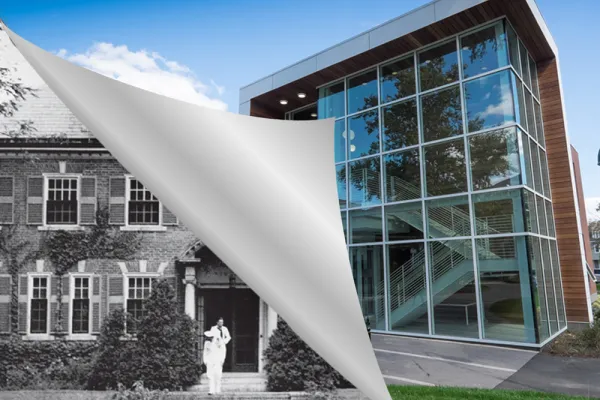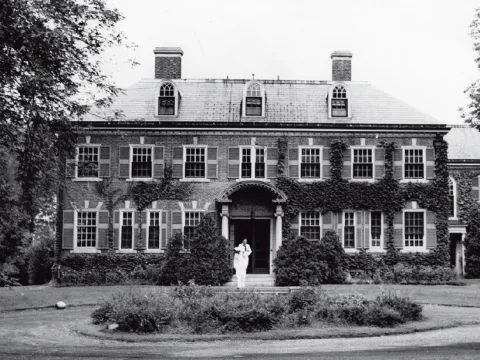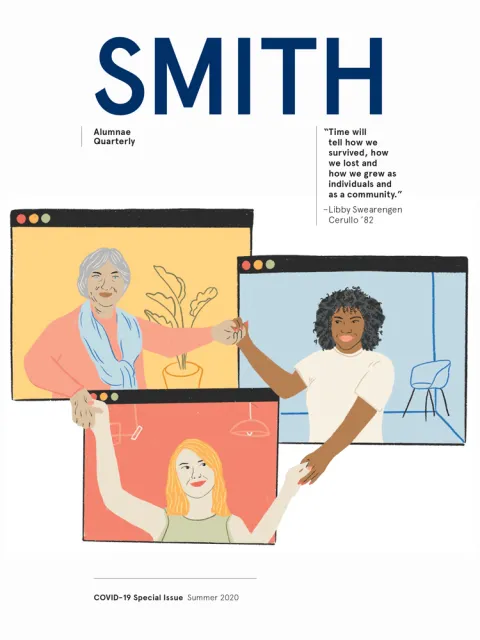Echoes of a Pandemic
Campus Life

Published June 18, 2020
Students quarantined on campus were told to refrain from going to downtown restaurants or leaving campus at all. Lectures and meetings were suspended. The spreading contagion sickened dozens of students; some developed pneumonia, and two died. Because Cooley Dickinson Hospital did not have enough beds to house the infected, Smith turned one of its residences, Baldwin House, into convalescent quarters.
This scenario was not in spring 2020, but in 1918, when the so-called Spanish flu erupted into a global pandemic. A century later, the campus—and the world—is experiencing its echo.
On September 24, 1918, the campus opened its fall semester as usual. But arriving students immediately began reporting flu-like symptoms, and for the next week began filling the beds in the old infirmary and in a college-owned house that was opened for sick students. By September 28, the local health board urged Smith to forbid students from congregating, going downtown or riding on trains. Parents of about 1,000 students—half the campus— drove back to Smith in private cars to bring their daughters home. Remaining students were quarantined in their residences.
Within two weeks, though, classes and lectures were reinstated and students returned to campus. But across the country the virus, it seems, was still lurking. When students returned from Thanksgiving break, influenza struck the campus again, and two houses were opened for sick students. In January 1919, another resurgence delayed the start of spring semester.
Meanwhile, as Dean Ada Comstock wrote in the February 1919 Smith Alumnae Quarterly, the opening of the new Elizabeth Mason Infirmary on Paradise Road was delayed numerous times. “Yet many times we have been sick at heart as we have realized how invaluable it would have been to us this year,” she wrote. She went on to note the inadequacy of seven “extemporized infirmaries” across campus.

When a deadly flu struck in 1918, sick students convalesced in Baldwin House. The Elizabeth Mason Infirmary, above, opened in 1920, just in time for the flu’s return. Photograph by Fred Chase, courtesy of the College Archives.
One bright note was that while the infirmary building was delayed, its furnishings arrived on time and were put to use in the temporary campus “hospitals.” (In 2015 the Mason Infirmary was torn down, replaced by the Schacht Center for Health and Wellness, erected adjacent to Scott gym.)
The following fall, in 1919, a few more cases arrived with students. A full-blown resurgence struck again when students returned from winter break in January 1920, forcing another campuswide quarantine. By then the new Mason Infirmary was open and sick students were cared for there.
Throughout the influenza years, the entire Smith community chipped in where it could. Faculty members tended ill students as they convalesced in Baldwin House. More than 40 Smith students who had passed a Red Cross course volunteered in staggered shifts at Cooley Dickinson Hospital, where at one point half of the hospital staff had fallen ill.
Class secretary Margot Riley ’81 recalls her grandmother Florence Bowman Riley 1919 telling her about how students worked on local farms during the campus shutdowns. “She often told me stories of how she and her sister, Grace Bowman Mawhinney 1920, who were both from Pittsburgh, worked in the tobacco fields outside of Northampton during the Spanish flu pandemic in 1918,” Riley says. “As able-bodied younger folks, that is how they pitched in.”
Across the country, alumnae stepped to the front lines, as they reported in class notes in the Quarterly. Auxiliary nurse Bertha Thresher Moore 1904 ran a private hospital for influenza patients in the Boston area when her physician husband was called to a military hospital in Georgia. Annah Hazen 1895 worked in a 3,000-bed military hospital as a bacteriologist. She wrote, “During the influenza I moved my micro scope [sic] into the observation ward, where many of the worst cases were placed, and was kept busy watching the changes of the blood during the development of the disease.” In February 1919, it was reported that Florence Cobb Montgomery 1911 died while serving as a nurse in Red Cross Service.
Today, a reminder of the 1918–20 flu pandemic can be heard anytime the bells ring out from College Hall. The Carlile Carillon there was donated in memory of Dorothea Carlile 1922, who died of influenza during her first year at Smith.
This story appears in the Summer 2020 issue of the Smith Alumnae Quarterly.

A Semester Like No Other: How the class of 2020 left campus with a proper send-off.
Smith’s All-Hands Crisis Response: Entire campus community takes up an array of challenges presented by a dangerous pandemic.
Connection Out of Isolation: 12 voices collaborate on a poem for our time.
Mission to Make Masks: Students, staff rev up sewing machines to fill a community need.
One Student: Studio art major Sophie Willard Van Sistine ’22 finds her niche writing comics.
Race for a Vaccine: Dr. Annie De Groot ’78 and her biotech firm are on the front line to stop COVID-19 in its tracks.
Virtual Togetherness: Quarantines fall away as Smith friends Zoom into one another’s living rooms.
Finding the Funny: An improv comedian’s tips for staying sane in the pandemic.
How Can I Help? From online classes to concerts and community fundraisers, alumnae find creative ways to ease the burden of those in need.
Feeling Community Through My Window: Teresa Kábana ’92 sends a dispatch from Madrid.
The Morning Call That Never Came: Death of a parent in the age of COVID-19 carries an extra layer of grief.
Racialization of Infectious Disease: As viruses spread, so does discrimination against marginalized groups.
Dawn of a New Day: Faith leaders impart messages of hope, acceptance and belief in our collective power to work for a better world.